Growth is a matter of survival for small businesses.
While deep-pocketed enterprises can afford to incur annual losses, smaller companies must continually increase sales to cover costs, attract talent and invest in future expansion.
Tracking sales growth enables SMBs to monitor the effectiveness of their sales tactics and make informed, data-driven planning decisions.
In this article, you’ll learn how to calculate your sales growth, seven proven strategies to boost revenue numbers and which metrics matter for measuring progress.
Key takeaways from sales growth
Steady sales growth helps small businesses compete, expand and plan for the future, even when rivals have bigger budgets.
Tracking the sales growth rate helps you spot problems early, assess which sales strategies work and make informed decisions.
Boost sales growth by refining buyer personas, building customer advocacy programs and prioritizing customer retention.
Pipedrive helps SMBs increase sales growth by tracking sales metrics, automating workflows and accelerating sales cycles with AI –try it free for 14 days.
What is sales growth?
Sales growth or sales growth rate, is the percentage increase in a company’s sales revenue over a specific period.
It measures how well your sales organization attracts customers, sells products and increases market penetration.
In SMB sales, it also provides key information that small businesses can use to maximize their limited resources, benchmark successes against competitors and make long-term strategic planning decisions that boost overall growth.
Why small businesses need to track annual sales growth:
- Spot problems like poor product-market fit early and act quickly before they escalate
- Improve sales performance by assessing the impact of different sales strategies and training programs
- Support business planning decisions such as price optimization, hiring, budgeting and improving digital marketing efforts
- Allocate resources to new products or markets with stronger growth potential
- Secure corporate funding by demonstrating steady and sustainable business growth
Imagine an IT company that has achieved 50% sales growth for two consecutive years.
If this year’s growth is only half of that, the owner might consider hiring new sales staff or increasing the sales budget to maintain the same rate of growth.
Before you can make similar decisions, you’ll need to learn how to calculate your own sales growth.
How to calculate sales growth
Calculating sales growth is simply a matter of comparing sales in your current period with those in the previous period.
The sales growth rate formula makes this easy:

For example, if last year’s sales were $500,000 and your current sales are $600,000, then your sales growth is 20%.
Sales growth = (600 − 500) / 500 × 100 = 20%
While you can track sales growth over any period, monthly, quarterly and annual assessments are most common.
Most SMBs will benefit from applying all three to the sales growth formula because of the different insights they generate:
Month-over-month |
|
Quarter-over-quarter |
|
Year-over-year |
|
Compare sales growth from one period to another to track performance over time. In general:
Higher, positive growth rates signal higher sales and more revenue
Lower or negative sales growth rates indicate declining performance and highlight the need for corrective measures, which you’ll learn about later
In addition to comparing current growth with past performance, you should also benchmark it against industry averages. Learn how to do that next.
What does good sales growth look like?
What good growth in sales looks like depends on your company’s size, market and competition.
Well-established small businesses may experience annual growth rates of 5%–10%, while tech startups can grow by 50% or more. The key is to compare yourself with similar companies in the same industry.
While specific industry benchmarks can be hard to find, the NYU Stern School of Business publishes a handy list of historical growth rates by sector that you can refer to.
Here are statistics for common small business sectors:
Sector | Expected revenue growth, next two years |
Advertising | 9.03% |
0.19% | |
Business and consumer services | 5.38% |
9.27% | |
Green and renewable energy | 15.06% |
11.67% | |
9.56% | |
9.05% |
Good sales growth is sustainable and consistent. While you may be eager to beat industry benchmarks, it’s more essential to generate steady, repeatable growth and strong profit margins.
Now you can benchmark your sales growth, it’s time to learn how to improve it.
7 sales growth strategies to expand your small business
Businesses that want to increase growth must manipulate one or more of four key levers: price, volume, acquisition and retention.
Here’s a summary of how each lever works:
| |
| |
| |
|
Here are seven practical strategies small businesses can use to pull one or more of these levers for sales growth success.
1. Use AI to speed up prospecting and outreach
AI sales tools enhance rep productivity and performance, allowing them to spend more time with prospects most likely to convert.
McKinsey lists AI as one of the five ways “growth laggards” drastically improve revenue growth.
Note: In this study, a growth laggard is a company with a negative compound annual growth rate and a negative change in EBITDA.
McKinsey finds that companies can increase sales by 100 basis points through the use of AI for prospecting – equivalent to 10% or more of their total annual growth.
An example of AI usage is Pipedrive’s AI-powered Sales Assistant, which analyzes your pipeline and pinpoints leads with high conversion potential based on several factors.
The feature is easily accessible from anywhere in Pipedrive, so reps can ask which deals to focus on next.
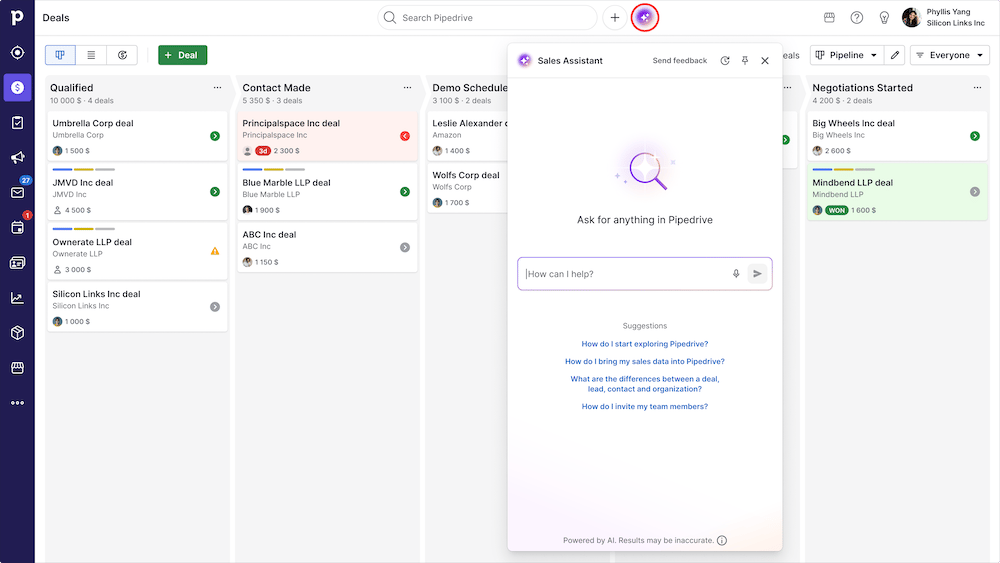
Rather than sales development reps guesstimating which prospects will convert, the sales assistant flags relevant prospects and suggests next steps.
Sending outreach emails is also faster with Pipedrive.
The customer relationship management (CRM) system’s AI email writer creates personalized outreach messages in a few clicks using data from your CRM:
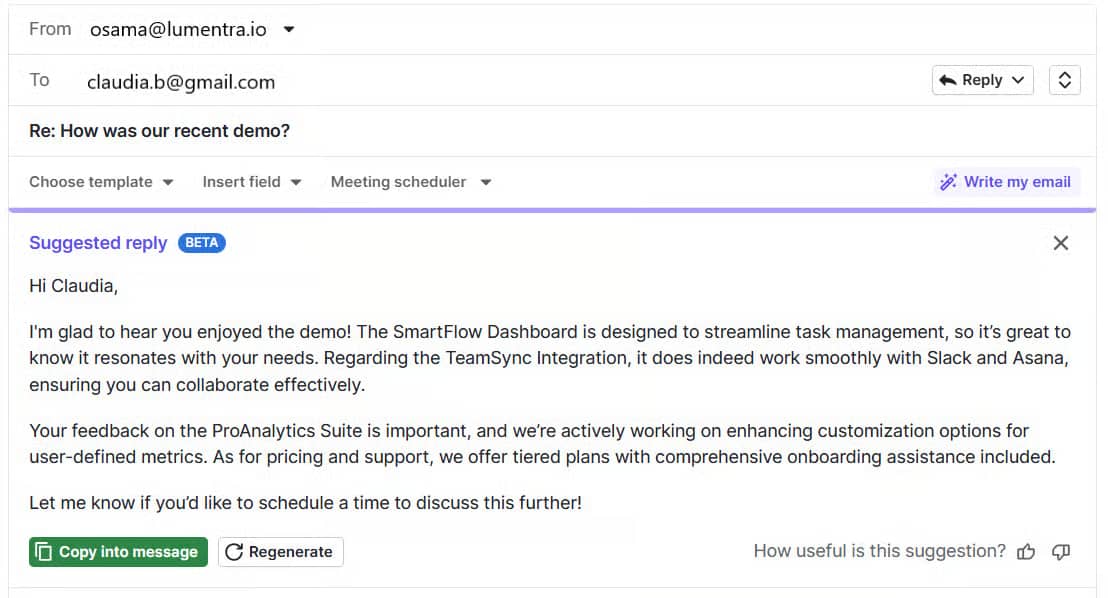
Pipedrive’s AI-powered Marketplace even helps reps work smarter by recommending relevant apps and integrations.
It analyzes your sales process, team size, industry and current tools to suggest effective app combinations.
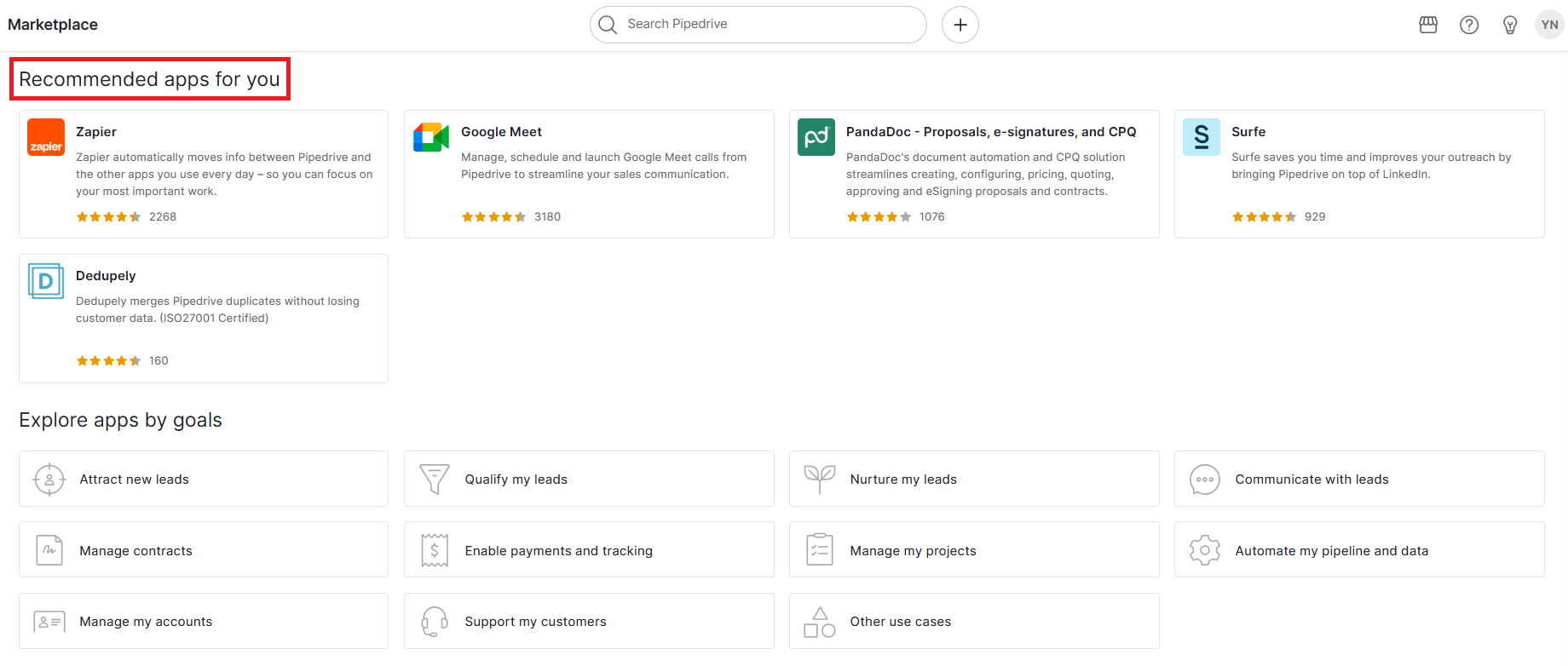
When reps spend more time on high-quality leads thanks to AI-assisted nurturing practices, sales growth quickly follows as they close more (and more valuable) deals.
2. Integrate your tool stack to drive efficiency
Connecting disparate tools through native automations means reps can spend more time selling and less time on busy work.
If your CRM, marketing automation platform and customer support tools don’t talk to each other, team members will waste time copying and pasting data between platforms. Worse, they may miss important information.
Pipedrive’s Marketplace solves this disconnect by tying your CRM to the rest of your tech stack.
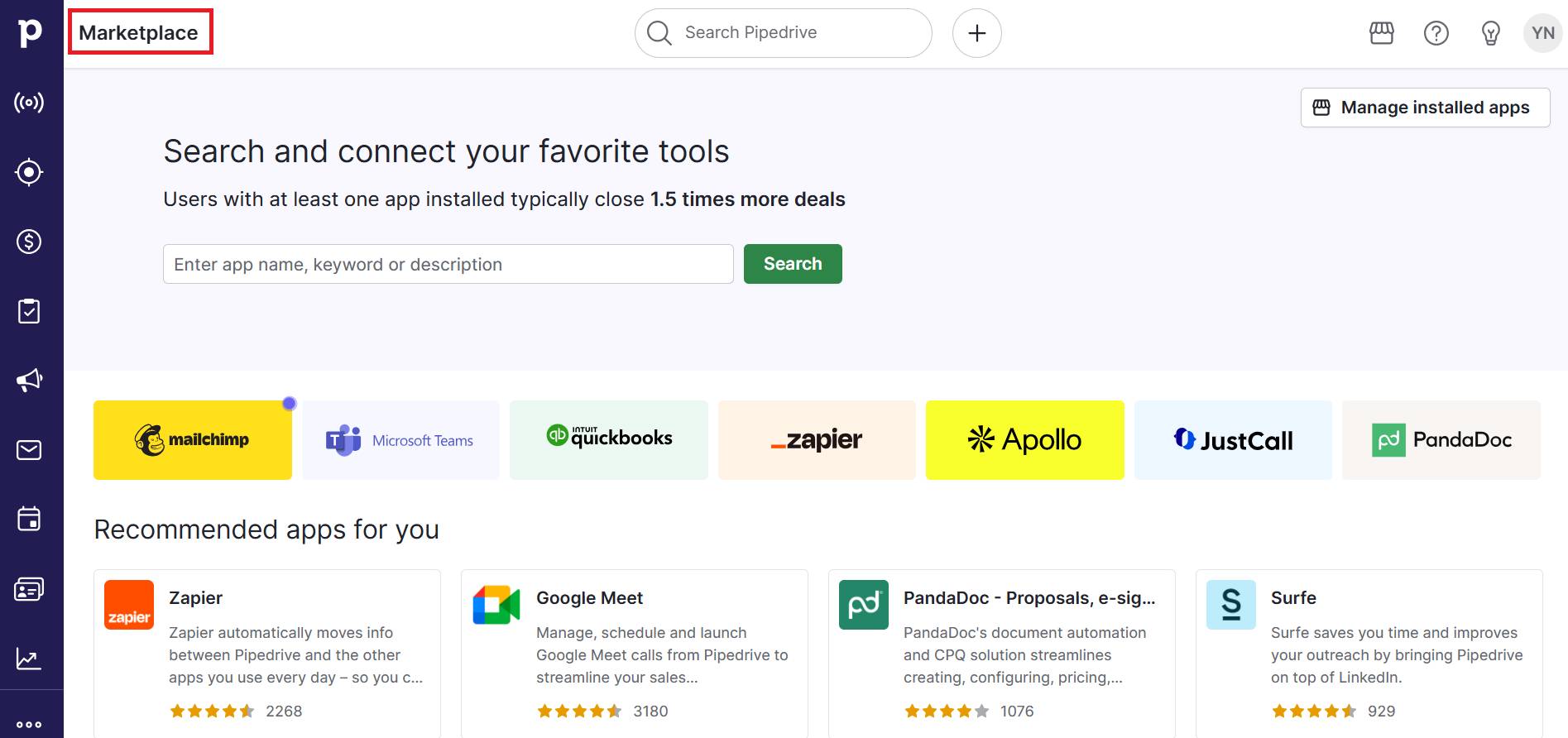
When a lead fills out a web form on your content management system (CMS), a new lead gets created in your CRM. When a deal moves to a new stage, it triggers an email without the rep having to open Outlook.
Alternatively, Pipedrive’s workflow automation feature lets you automate tasks without needing to connect different tools.
For example, when a lead gets added to Pipedrive, you can automatically create a deal, assign it to the right sales rep and schedule a follow-up call.
How Pipedrive helps
Home décor and interior design company Pole Design saves over two days each week using Pipedrive’s automations.
Integrating Pipedrive with Shopify through Zapier automatically creates form submissions and website orders into deals. It significantly simplifies order processing and customer interactions.
As owner Samuel Ficek says, Pipedrive is positioning the company for future success:
Workflow automation and native integrations enable sales teams to complete essential tasks without lifting a finger. Reps get more time to spend on prospects, meaning more – and potentially higher value – sales.
3. Create a cohort of customer advocates
A customer advocacy program helps small businesses compete on shoestring budgets by turning delighted customers into high-converting sales tools.
An advocate’s authentic and organic recommendations are key factors in the decision-making process.
Consumers in the US and Europe report that recommendations from friends and family have the greatest influence on their purchasing decisions. Online reviews are the second-most-trusted source of recommendations.
Advocacy takes several forms, including:
Writing online reviews
Creating user-generated content
Participating in customer success stories
Referring colleagues and peers
Well-designed customer loyalty programs are an effective way of encouraging customer advocacy.
For example, hosting platform WPEngine offers agencies a range of benefits for agencies who join its partner program:
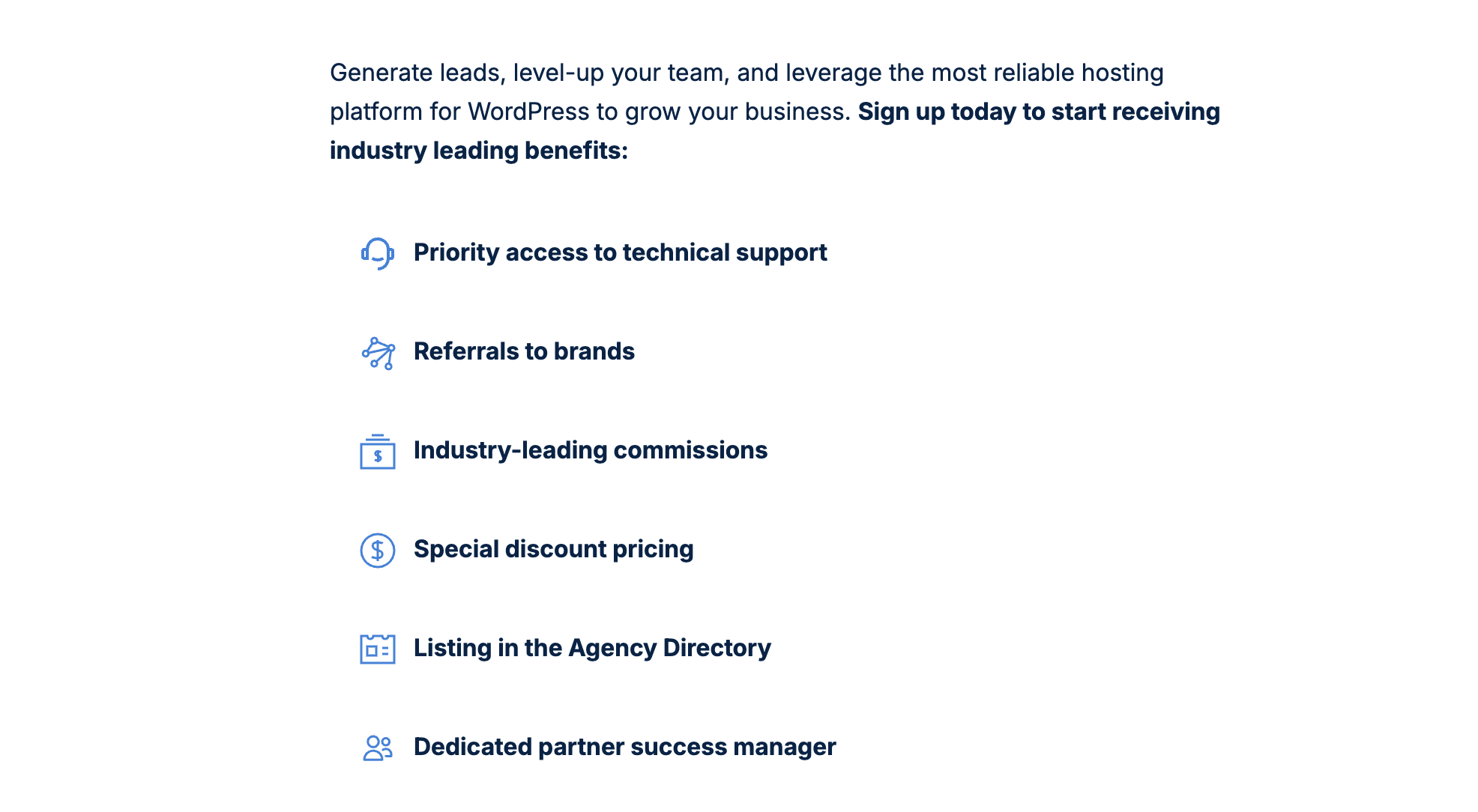
In this case, WPEngine incentivizes partners to recommend the brand to clients and colleagues in return for priority support and a directory listing.
Collaborate with the most active advocates to develop customer success stories and other sales tools that reps can leverage to convert more deals and drive sales growth.
Net Promoter Score (NPS) surveys are another way to find and engage potential advocates.
Use Pipedrive’s SurveySparrow integration to send NPS surveys at regular intervals or after customer milestones and support requests. Here’s what a survey looks like:
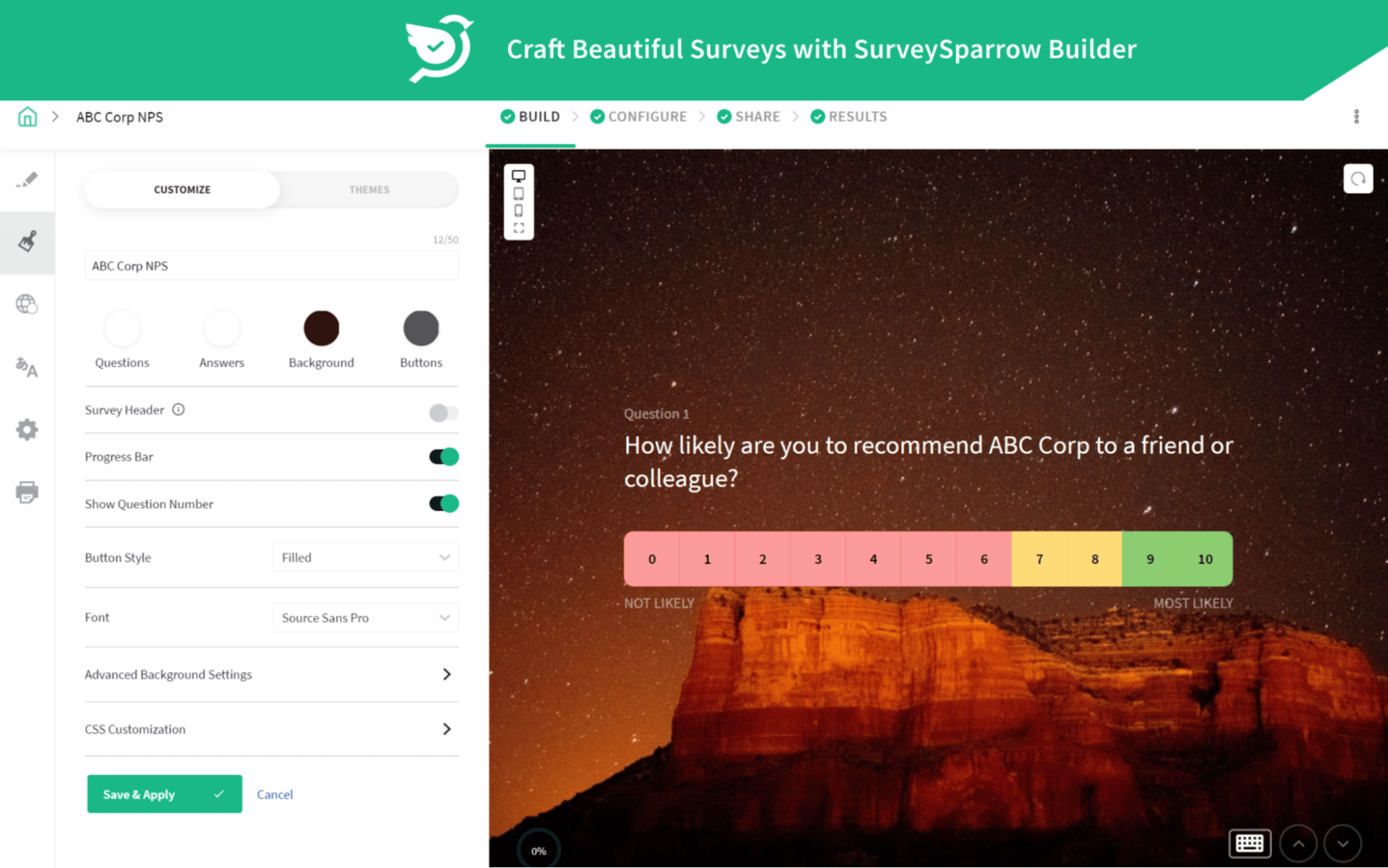
Ask customers who consistently rate your company a nine or 10 to write a review or leave a testimonial.
4. Sharpen your ICPs and buyer personas
Increase sales growth and conversion rates by homing in on the best quality leads through well-defined ideal customer profiles (ICPs) and buyer personas.
Here’s what each term means:
ICPs are semi-fictional representations of your ideal company. It includes details such as industry, size and location.
Buyer personas are fictional representations of a specific buyer within a company. It includes details like job title, responsibilities, goals, pain points, buying behavior and decision-making process.
Here’s what a complete buyer persona looks like:
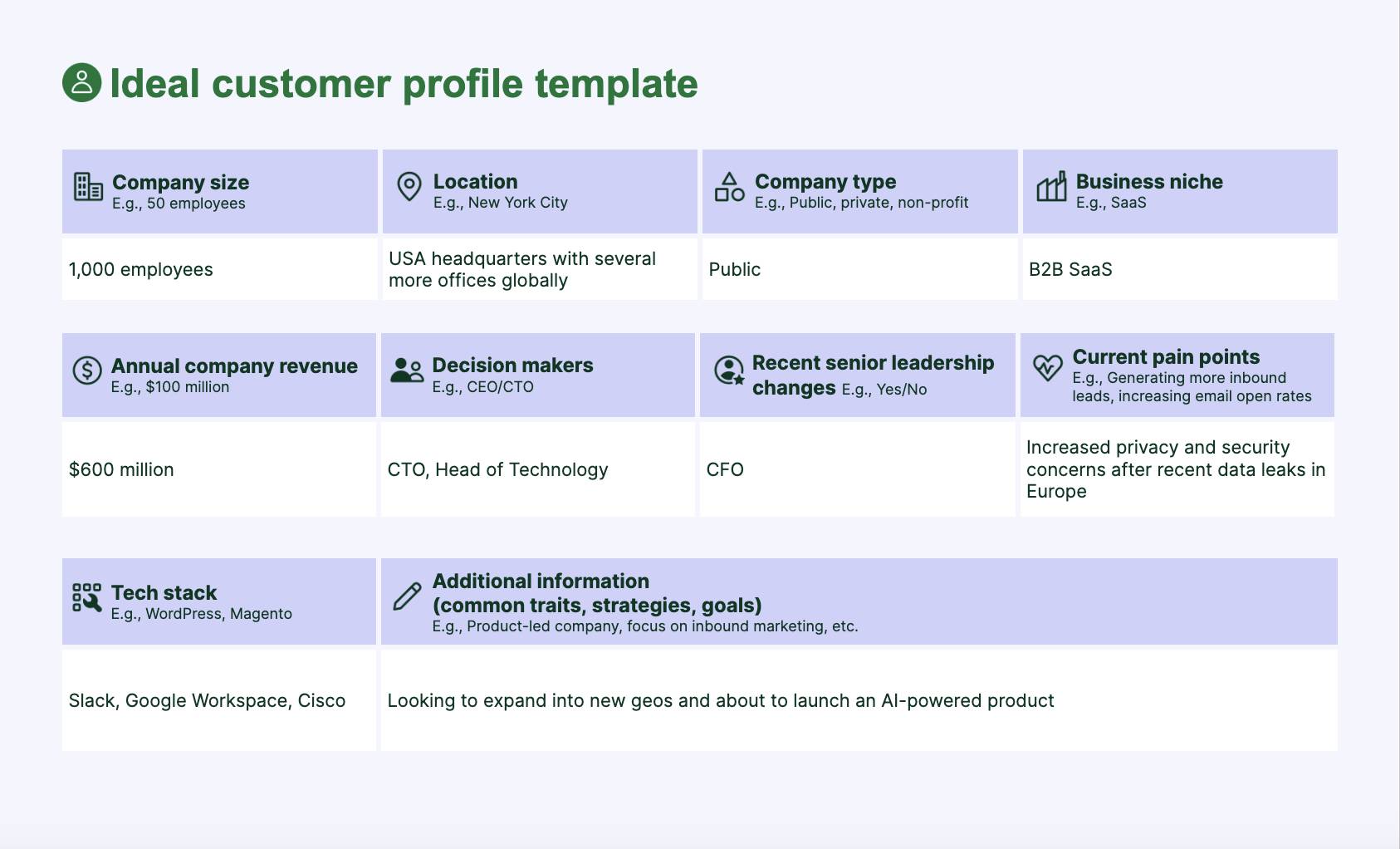
Create an ICP or buyer persona by finding your best customers and identifying their common traits.
Your CRM can help you filter customers with high CLVs, long-running subscriptions and low-support requests.
Then look for similar traits like:
Company size
Industry
Decision maker
Pain point
Goal
Tech stack
Use the information to create detailed ICPs and buyer personas your sales team can refer to while prospecting.
It will make it easy for sales reps to build relevant prospect lists, score new leads and tailor outreach strategies.
Reps can use Pipedrive’s email segmentation feature to send the right message to each persona at scale.
Campaigns by Pipedrive allows sales and marketing teams to filter email lists based on demographic and campaign data – think industry, job role, email open rate and other criteria that align with ICPs or buyer personas.
Pre-made templates and WYSIWYG (What You See Is What You Get) editors enable anyone to create professional emails, while built-in email analytics lets teams track and optimize performance.
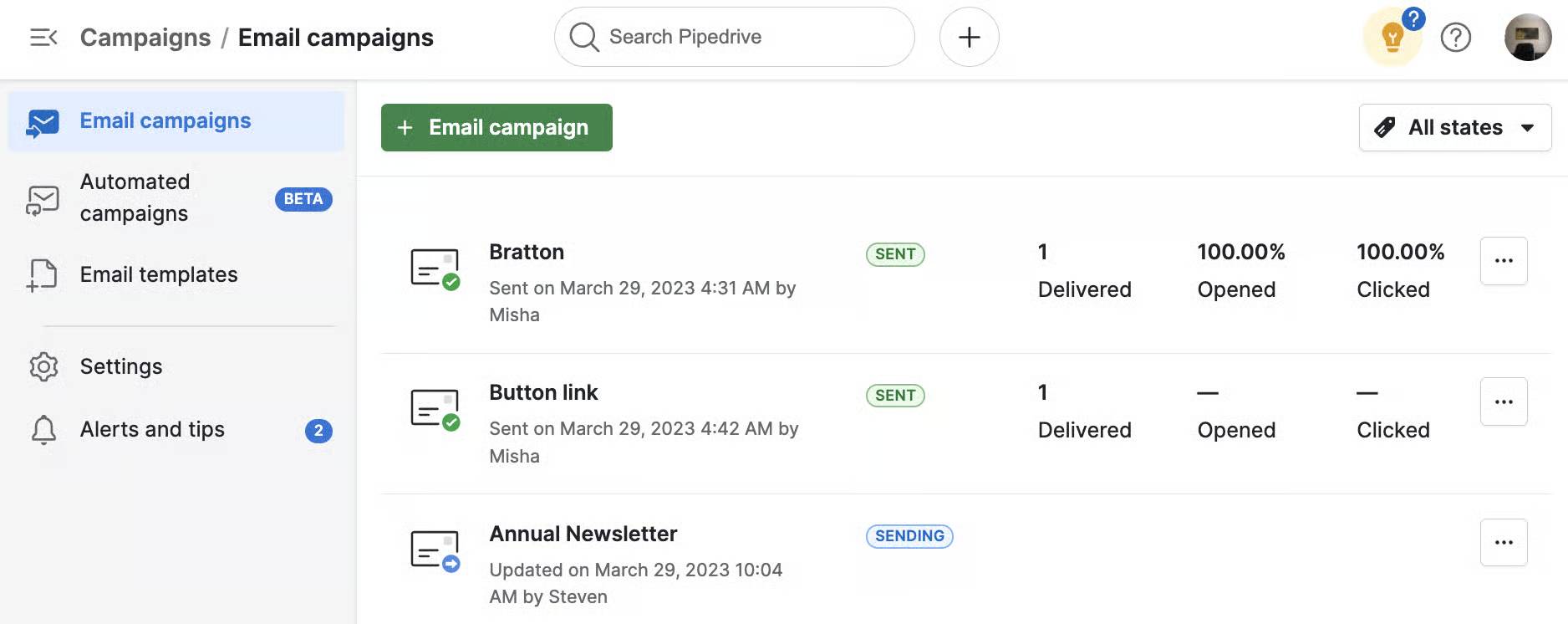
In both cases, ICPs and buyer personas help reps deliver the right message to the right prospects, increasing sales growth in the process.
How Pipedrive helps
Full-service digital agency Spark Interactive has used Campaigns by Pipedrive to drive a 12% average annual increase in sales revenue.
Because the email marketing tool integrates seamlessly with Pipedrive, the agency can create, send and track campaigns from one place.
Spark Interactive also uses:
Pipedrive’s AI-powered Sales Assistant to get real-time insights and personalized sales recommendations
Custom dashboards to track email volume, texts and other core activities
Automated workflows to eliminate repetitive work and keep prospects engaged
Custom fields to tag lead source, type of inquiry and landing page URL to improve marketing analytics
As Mackey Kandarajah, a marketing technology specialist at Spark Interactive, says:
Centralizing sales and marketing efforts has helped Spark Interactive drive predictable revenue without expanding its sales team.
Better understand your customers with our Buyer Persona Templates
5. Upgrade your sales team
Sometimes, the only way to boost sales is to have bigger or better sales teams.
Small businesses with limited budgets can’t afford to have people filling seats. You need a high-performing team that aligns with your sales goals and customers.
If you already have top sales performers, see what qualities make them effective salespeople in your industry. These may be:
Assertiveness
Inquisitiveness
Optimism
Organization
Honesty
A compelling job description will highlight the skills, attributes and experience you’re looking for, but asking the right sales interview questions is also crucial.
Here are some key questions that help you assess each candidate’s qualities.
Must-ask sales interview questions:
- How do you organize your day?
- How would you explain our product or service in a single sentence?
- How did you land your most successful sale?
- How do you keep a smile on your face during a hard day?
- Have you ever asked a prospect you lost why they chose not to buy?
Pipedrive customers can use their CRM as an applicant tracking system by creating a customized pipeline like the one below:

Add each candidate as a deal in your pipeline, complete with all the necessary information (resumes, notes, etc.) for decision-making.
The pipeline keeps you organized and on track so you can equip your team with the best available candidates and start growing sales faster.
6. Prioritize customer retention
Customer retention increases sales growth by delivering repeat revenue and reducing acquisition costs.
Every customer your business retains is one less prospect your sales team has to convert to meet your sales goals.
Small businesses can use the following strategies to increase loyalty and boost retention rates:
Create a loyalty program | Why: Meaningfully reward continued business. How: Create a program that offers discounts, exclusive access to new features or other benefits based on spending. |
Provide exceptional customer support | Why: Keep customers happy by resolving issues quickly. How: Offer 24/7 support with chatbots for instant responses. Create a knowledge base and community forum for self-service support. |
Personalize customer experiences | Why: Increase value by tailoring solutions to each customer. How: Use CRM data to personalize messaging. Create bespoke onboarding workflows. |
Collect and act on customer feedback | Why: Show users you value their opinions. How: Create a customer-led product roadmap. Offer multiple ways for customers to provide feedback, including web forms and email. |
While the strategies above encourage customers to renew of their own volition, reps should be doing everything they can to renew contracts before they lapse.
Give them the tools they need in the form of a customizable pipeline like this one:

Use Pipedrive’s workflow automation feature to create a trigger that moves a deal into the renewal pipeline three months before the contract ends.
Create a sales activity for the sales rep to contact the customer about their renewal and set periodic reminders every 30 days to ensure the rep doesn’t forget.
Combining rep-led outreach with the above retention strategies will minimize the number of customers who churn and maximize sales growth.
7. Experiment with new sales tactics
Sometimes, growing your sales requires an innovative new sales strategy or approach that reinvigorates your team and unlocks bigger deals.
Consider trying a new sales tactic if your sales growth has been in steady – but not severe – decline for the past few quarters. It could be the revitalizing approach your team needs.
Here are four proven sales methodologies to try:
Focuses on four types of questions (situation, problem, implication and need payoff) with the goal of quickly identifying the root of the problem and building a foundation for long-term success. | |
Aims to teach prospects, take control of conversations and tailor sales processes to customer needs. | |
Outlines how your product or service can help prospects overcome a problem. | |
Treats salespeople and prospects as equals who are both invested in the sale and want to come to mutually beneficial conclusions. |
Choose the right sales methodology for your business by pinpointing your team’s struggles.
If reps can’t gauge a prospect’s pain points, for example, a methodology that focuses on the buyer’s needs makes sense. Try SPIN selling in this case.
If sales are taking too long to close, try a methodology that encourages reps to take more control. Challenger sales may work well.
Whichever method you choose, run regular sales coaching sessions to get your team up to speed and keep them on track. Observing your sales growth periodically – along with other sales KPIs – is an effective way to monitor team performance progress.
How to track and analyze sales growth over time
While sales growth can flag when things are going right or wrong, it doesn’t always provide the insights business owners, stakeholders and sales managers need to improve operations.
Bring your sales performance into sharper focus by tracking sales growth alongside these other important sales metrics:
Win rate |
|
Sales cycle length |
|
Average deal size |
|
|
By tracking key metrics, you can see what a dip in sales growth actually means.
If your sales cycle length increases, it may indicate a problem with your pipeline. If the average deal size decreases, you could look for ways to cross-sell or upsell prospects.
A CRM lets you track these metrics automatically and centralize them in one place.
For example, Pipedrive customers can use the platform’s customizable dashboards to monitor the sales growth metrics that matter most.
Here’s what a potential dashboard could look like:
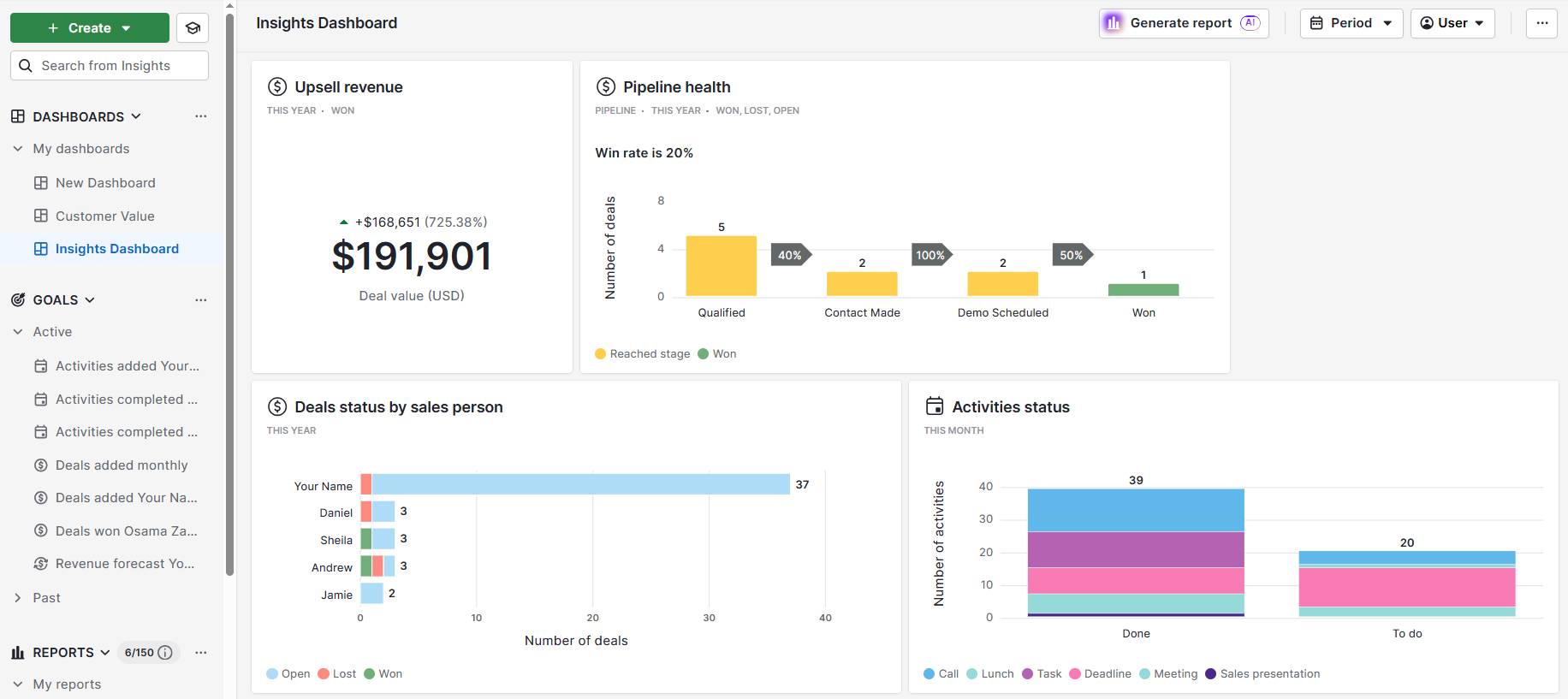
Users can also integrate the CRM with sales analytics and visualization software like SyncHub or Dear Lucy to create real-time dashboards.
Review key metrics regularly. Weekly or monthly monitoring will be frequent enough to spot issues quickly without requiring a significant chunk of every day for related tasks.
Final thoughts
Small business sales growth doesn’t happen by accident.
It’s the result of deliberate choices, experimenting with new strategies and obsessively tracking your sales performance.
Consider using an AI-powered CRM like Pipedrive to give your sales team all the tools they need to succeed. Sign up for a 14-day free trial to see how your reps can work harder and smarter to close more deals.






